Pulsed Electric Field-Assisted “Green” Extraction of Betalains and Phenolic Compounds from Opuntia stricta var. dillenii Prickly Pears: Process Optimization and Biological Activity of Green Extracts
Abstract
1. Introduction
2. Materials and Methods
2.1. Plant Material and Chemicals
2.2. Pulsed Electric Fields (PEF) Equipment
2.3. Determination of Cell Disintegration Index (Zp)
2.4. Pulsed Electric Fields (PEF) Treatment
2.5. Optimization of SLE and PEF-Assisted SLE Process
2.5.1. SLE Process and PEF-Assisted SLE Process
2.5.2. Experimental Design
2.6. Characterization of SLE and PEF-Assisted SLE OPD Extracts
2.6.1. Total Phenolic Compounds (TPC) Analysis
2.6.2. Total Flavonoid (FC) Analysis
2.6.3. Total Betalain Analysis
2.6.4. Determination of Antioxidant Capacity
2.6.5. Determination of the Anti-Inflammatory Activity
2.6.6. HPLC-DAD-ESI-Qtof Analysis of Bioactive Compounds
2.7. Statistical Analysis
3. Results and Discussion
3.1. Physicochemical Characteristics of Opuntia Stricta var. Dillenii Whole Fruit (OPD)
3.2. Optimization of Solid–Liquid Extraction (SLE) of Bioactive Compounds from OPD Whole Fruit Puree
3.2.1. Bioactive Compounds and Biological Activities of SLE Extracts
3.2.2. Model Fitting and RSM Analysis for the SLE Process
3.2.3. Optimal Conditions for the SLE Process
3.2.4. HPLC-DAD-ESI-Qtof Analysis of Bioactives in the SLE Extract from OPD Whole Fruit Puree
3.3. Optimization of the PEF-Assisted SLE Process of Bioactives from OPD
3.3.1. Optimization of the PEF Pre-Treatment: Cell Membrane Disintegration Degree
3.3.2. Model Fitting and RSM Analysis for PEF Pre-Treatment
3.3.3. Optimization of PEF-Assisted SLE of Bioactive Compounds from OPD
3.3.4. HPLC-DAD-ESI-Qtof Analysis of Bioactive Compounds of OPD Extracts
4. Conclusions
Supplementary Materials
Author Contributions
Funding
Data Availability Statement
Acknowledgments
Conflicts of Interest
Abbreviations
| DW | Dry Weight |
| E | Electric Field |
| EtOH | Ethanol |
| FC | Total Flavonoid Content |
| FC-CCD | Face-Centered Central Composite Design |
| HPLC | High-Performance Liquid Chromatography |
| OPD | Opuntia stricta var. dillenii |
| PEF | Pulsed Electric Fields |
| QE | Quercetin Equivalent |
| RSM | Response Surface Methodology |
| SLE | Solid–Liquid green Extraction |
| TPC | Total Phenolic Compounds |
| WT | Energy Input |
| Zp | Cell Disintegration Index |
References
- Betancourt, C.; Cejudo-Bastante, M.J.; Heredia, F.J.; Hurtado, N. Pigment composition and antioxidant capacity of betacyanins and betaxanthins fractions of Opuntia dillenii (Ker Gawl) Haw cactus fruit. Food Res. Int. 2017, 101, 173–179. [Google Scholar] [CrossRef]
- Medina, E.D.; Rodríguez-Rodríguez, E.M.; Romero, C.D. Chemical characterization of Opuntia dillenii and Opuntia ficus indica fruits. Food Chem. 2007, 103, 38–45. [Google Scholar] [CrossRef]
- Shirazinia, R.; Rahimi, V.B.; Kehkhaie, A.R.; Sahebkar, A.; Rakhshandeh, H.; Askari, V.R. Opuntia dillenii: A forgotten plant with promising pharmacological properties. J. Pharmacopunct. 2019, 22, 16–27. [Google Scholar] [CrossRef] [PubMed]
- Madrigal-Santillán, E.; Portillo-Reyes, J.; Madrigal-Bujaidar, E.; Sánchez-Gutiérrez, M.; Mercado-Gonzalez, P.; Izquierdo-Vega, J.; Vargas-Mendoza, N.; Álvarez-González, I.; Fregoso-Aguilar, T.; Delgado-Olivares, L.; et al. Opuntia Genus in Human Health: A Comprehensive Summary on Its Pharmacological, Therapeutic and Preventive Properties. Part 1. Horticulturae 2022, 8, 88. [Google Scholar] [CrossRef]
- Bouhrim, M.; Ouassou, H.; Boutahiri, S.; Daoudi, N.E.; Mechchate, H.; Gressier, B.; Eto, B.; Imtara, H.; Alotaibi, A.A.; Al-Zharani, M.; et al. Opuntia dillenii (Ker Gawl.) Haw., Seeds Oil Antidiabetic Potential Using In Vivo, In Vitro, In Situ, and Ex Vivo Approaches to Reveal Its Underlying Mechanism of Action. Molecules 2021, 26, 1677. [Google Scholar] [CrossRef]
- Elouazkiti, M.; Elyacoubi, H.; Gadhi, C.; Bouamama, H.; Atmane, R. Exploring the Chemical Profile and Biological Activities of Opuntia dillenii Extracts and Seed Oil. Nat. Prod. Res. 2025, 1–11. [Google Scholar] [CrossRef]
- Sinicropi, M.S.; Baldino, N.; Ceramella, J.; Iacopetta, D.; Scali, E.; Basile, G.; Saturnino, C.; Catalano, A. Opuntia ficus indica (L.) Mill. An Ancient Plant Source of Nutraceuticals. Curr. Top. Med. Chem. 2022, 22, 1736–1749. [Google Scholar] [CrossRef]
- Armas Diaz, Y.; Machì, M.; Salinari, A.; Mazas Pérez-Oleaga, C.; Martínez López, N.M.; Briones Urbano, M.; Cianciosi, D. Prickly pear fruits from Opuntia ficus-indica varieties as a source of potential bioactive compounds in the Mediterranean diet. Mediterr. J. Nutr. Metab. 2022, 15, 581–592. [Google Scholar] [CrossRef]
- Zeghbib, W.; Boudjouan, F.; Vasconcelos, V.; Lopes, G. Phenolic Compounds’ Occurrence in Opuntia species and Their Role in the Inflammatory Process: A Review. Molecules 2022, 27, 4763. [Google Scholar] [CrossRef]
- Calvi, P.; Terzo, S.; Amato, A. Betalains: Colours for Human Health. Nat. Prod. Res. 2022, 37, 1746–1765. [Google Scholar] [CrossRef]
- Castellar, R.; Obón, J.M.; Alacid, M.; Fernández-López, J.A. Color Properties and Stability of Betacyanins from Opuntia fruits. J. Agric. Food Chem. 2003, 51, 2772–2776. [Google Scholar] [CrossRef]
- Gómez-López, I.; Lobo-Rodrigo, G.; Portillo, M.P.; Cano, M.P. Characterization, Stability, and Bioaccessibility of Betalain and Phenolic Compounds from Opuntia stricta var. Dillenii Fruits and Products of Their Industrialization. Foods 2021, 10, 1593. [Google Scholar] [CrossRef]
- Lefebvre, T.; Destandau, E.; Lesellier, E. Selective extraction of bioactive compounds from plants using recent extraction techniques: A review. J. Chromatogr. A 2021, 1635, 461770. [Google Scholar] [CrossRef] [PubMed]
- Gómez-Maqueo, A.; Welti-Chanes, J.; Cano, M.P. Release mechanisms of bioactive compounds in fruits submitted to high hydrostatic pressure: A dynamic microstructural analysis based on prickly pear cells. Food Res. Int. 2020, 130, 108909. [Google Scholar] [CrossRef] [PubMed]
- Gomes, S.V.F.; Portugal, L.A.; dos Anjos, J.P.; de Jesus, O.N.; de Oliveira, E.J.; David, J.P.; David, J.M. Accelerated solvent extraction of phenolic compounds exploiting a Box-Behnken design and quantification of five flavonoids by HPLC-DAD in Passiflora species. Microchem. J. 2017, 132, 28–35. [Google Scholar] [CrossRef]
- Barba, F.J.; Zhu, Z.; Koubaa, M.; Sant’Ana, A.S.; Orlien, V. Green alternative methods for the extraction of antioxidant bioactive compounds from winery wastes and by-products: A review. Trends Food Sci. Technol. 2016, 49, 96–109. [Google Scholar] [CrossRef]
- Gómez-López, I.; Lobo-Rodrigo, G.; Portillo, M.P.; Cano, M.P. Ultrasound-Assisted “Green” Extraction (UAE) of Antioxidant Compounds (Betalains and Phenolics) from Opuntia stricta var. Dilenii’s Fruits: Optimization and Biological Activities. Antioxidants 2021, 10, 1786. [Google Scholar] [CrossRef]
- Barros, F.; Dykes, L.; Awika, J.M.; Rooney, L.W. Accelerated Solvent Extraction of Phenolic Compounds from Sorghum Brans. J. Cereal Sci. 2013, 58, 305–312. [Google Scholar] [CrossRef]
- Karunanithi, A.; Venkatachalam, S. Ultrasonic-assisted Solvent Extraction of Phenolic Compounds from Opuntia Ficus-indica Peel: Phytochemical Identification and Comparison with Soxhlet Extraction. J. Food Process Eng. 2019, 42, e13126. [Google Scholar] [CrossRef]
- Melgar, B.; Dias, M.I.; Barros, L.; Ferreira, I.C.F.R.; Rodriguez-Lopez, A.D.; Garcia-Castello, E.M. Ultrasound and Microwave Assisted Extraction of Opuntia Fruit Peels Biocompounds: Optimization and Comparison Using RSM-CCD. Molecules 2019, 24, 3618. [Google Scholar] [CrossRef]
- Carpentieri, S.; Soltanipour, F.; Ferrari, G.; Pataro, G.; Donsì, F. Emerging green techniques for the extraction of antioxidants from agri-food by-products as promising ingredients for the food industry. Antioxidants 2021, 10, 1417. [Google Scholar] [CrossRef] [PubMed]
- Bocker, R.; Silva, E.K. Pulsed electric field assisted extraction of natural food pigments and colorings from plant matrices. Food Chem. X 2022, 15, 100398. [Google Scholar] [CrossRef] [PubMed]
- Papachristou, I.; Nazarova, N.; Wüstner, R.; Lina, R.; Frey, W.; Silve, A. Biphasic Lipid Extraction from Microalgae after PEF-Treatment Reduces the Energy Demand of the Downstream Process. Biotechnol. Biofuels Bioprod. 2025, 18, 12. [Google Scholar] [CrossRef]
- Surano, B.; Leiva, G.; Marshall, G.; Maglietti, F.; Schebor, C. Pulsed electric fields using a multiple needle chamber to improve bioactive compounds extraction from unprocessed Opuntia ficus-indica fruits. J. Food Eng. 2022, 317, 110864. [Google Scholar] [CrossRef]
- Morales-de la Peña, M.; Arredondo-Ochoa, T.; Welti-Chanes, J.; Martín-Belloso, O. Application of moderate intensity pulsed electric fields in red prickly pears and soymilk to develop a plant-based beverage with potential health-related benefits. Innov. Food Sci. Emerg. Technol. 2023, 88, 103421. [Google Scholar] [CrossRef]
- Moussa-Ayoub, T.E.; Jaeger, H.; Youssef, K.; Knorr, D.; El-Samahy, S.; Kroh, L.W.; Rohn, S. Technological characteristics and selected bioactive compounds of Opuntia dillenii cactus fruit juice following the impact of pulsed electric field pre-treatment. Food Chem. 2016, 210, 249–261. [Google Scholar] [CrossRef]
- Koubaa, M.; Barba, F.J.; Grimi, N.; Mhemdi, H.; Koubaa, W.; Boussetta, N.; Vorobiev, E. Recovery of colorants from red prickly pear peels and pulps enhanced by pulsed electric field and ultrasound. Innov. Food Sci. Emerg. Technol. 2016, 37, 336–344. [Google Scholar] [CrossRef]
- Donsiì, F.; Ferrari, G.; Fruilo, M.; Pataro, G. Pulsed Electric Field-Assisted Vinification of Aglianico and Piedirosso Grapes. J. Agric. Food Chem. 2010, 58, 11606–11615. [Google Scholar] [CrossRef]
- Bobinaitė, R.; Pataro, G.; Lamanauskas, N.; Šatkauskas, S.; Viškelis, P.; Ferrari, G. Application of pulsed electric field in the production of juice and extraction of bioactive compounds from blueberry fruits and their by-products. J. Food Sci. Technol. 2015, 52, 5898–5905. [Google Scholar] [CrossRef]
- Carpentieri, S.; Ferrari, G.; Pataro, G. Optimization of Pulsed Electric Fields-Assisted Extraction of Phenolic Compounds from White Grape Pomace Using Response Surface Methodology. Front. Sustain. Food Syst. 2022, 6. [Google Scholar] [CrossRef]
- Agbo, M.O.; Uzor, P.F.; Akazie Nneji, U.N.; Eze Odurukwe, C.U.; Ogbatue, U.B.; Mbaoji, E.C. Antioxidant, Total Phenolic and Flavonoid Content of Selected Nigerian Medicinal Plants. Dhaka Univ. J. Pharm. Sci. 2015, 14, 35–41. [Google Scholar] [CrossRef]
- Prakash Maran, J.; Manikandan, S. Response surface modeling and optimization of process parameters for aqueous extraction of pigments from prickly pear (Opuntia ficus-indica) fruit. Dye. Pigment. 2012, 95, 465–472. [Google Scholar] [CrossRef]
- Benzie, I.F.F.; Strain, J.J. The Ferric Reducing Ability of Plasma (FRAP) as a Measure of “Antioxidant Power”: The FRAP Assay. Anal. Biochem. 1996, 239, 70–76. [Google Scholar] [CrossRef] [PubMed]
- Fazio, A.; Iacopetta, D.; La Torre, C.; Ceramella, J.; Muià, N.; Catalano, A.; Carocci, A.; Sinicropi, M.S. Finding solutions for agricultural wastes: Antioxidant and antitumor properties of pomegranate Akko peel extracts and β-glucan. Food Funct. 2018, 9, 6618–6631. [Google Scholar] [CrossRef] [PubMed]
- Gómez-Maqueo, A.; García-Cayuela, T.; Welti-Chanes, J.; Cano, M.P. Enhancement of anti-inflammatory and antioxidant activities of prickly pear fruits by high hydrostatic pressure: A chemical and microstructural approach. Innov. Food Sci. Emerg. Technol. 2019, 54, 132–142. [Google Scholar] [CrossRef]
- Both, S.; Chemat, F.; Strube, J. Extraction of polyphenols from black tea—Conventional and ultrasound assisted extraction. Ultrason. Sonochem. 2014, 21, 1030–1034. [Google Scholar] [CrossRef]
- Zhang, D.; Lanier, S.M.; Downing, J.A.; Avent, J.L.; Lum, J.; McHale, J.L. Betalain pigments for dye-sensitized solar cells. J. Photochem photobiol. A Chem. 2008, 195, 72–80. [Google Scholar] [CrossRef]
- Lakache, Z.; Aliboudhar, H.; Laassami, A.; Metidji, H.; Hacib, H.; Tounsi, H.; Kameli, A. Evaluation of Antioxidant, Antibacterial, Antalgic and Anti-Inflammatory Properties of Crataegus azarolus. Bull. Pharm. Sci. Assiut Univ. 2023, 46, 867–880. [Google Scholar] [CrossRef]
- Coy-Barrera, E. Chapter 17—Analysis of betalains (betacyanins and betaxanthins). In Recent Advances in Natural Products Analysis; Sanches Silva, A., Nabavi, S.F., Saeedi, M., Nabavi, S.M., Eds.; Elsevier: Amsterdam, The Netherlands, 2020; pp. 593–619. [Google Scholar]
- Lu, W.; Chiu, C.; Chan, Y.; Mulio, A.T.; Li, P. Recent Research on Different Parts and Extracts of Opuntia dillenii and Its Bioactive Components, Functional Properties, and Applications. Nutrients 2023, 15, 2962. [Google Scholar] [CrossRef]
- Missaoui, M.; D’Antuono, I.; D’Imperio, M.; Linsalata, V.; Boukhchina, S.; Logrieco, A.F.; Cardinali, A. Characterization of Micronutrients, Bioaccessibility and Antioxidant Activity of Prickly Pear Cladodes as Functional Ingredient. Molecules 2020, 25, 2176. [Google Scholar] [CrossRef]
- Luengo, E.; Condón-Abanto, S.; Álvarez, I.; Raso, J. Effect of Pulsed Electric Field Treatments on Permeabilization and Extraction of Pigments from Chlorella vulgaris. J. Membr. Biol. 2014, 247, 1269–1277. [Google Scholar] [CrossRef]
- Loginova, K.V.; Lebovka, N.I.; Vorobiev, E. Pulsed electric field assisted aqueous extraction of colorants from red beet. J. Food Eng. 2011, 106, 127–133. [Google Scholar] [CrossRef]
- Nowacka, M.; Tappi, S.; Wiktor, A.; Rybak, K.; Miszczykowska, A.; Czyzewski, J.; Drozdzal, K.; Witrowa-Rajchert, D.; Tylewicz, U. The Impact of Pulsed Electric Field on the Extraction of Bioactive Compounds from Beetroot. Foods 2019, 8, 244. [Google Scholar] [CrossRef]
- López, N.; Puértolas, E.; Condón, S.; Raso, J.; Alvarez, I. Enhancement of the extraction of betanine from red beetroot by pulsed electric fields. J. Food Eng. 2009, 90, 60–66. [Google Scholar] [CrossRef]
- Brianceau, S.; Turk, M.; Vitrac, X.; Vorobiev, E. Combined densification and pulsed electric field treatment for selective polyphenols recovery from fermented grape pomace. Innov. Food Sci. Emerg. Technol. 2015, 29, 2–8. [Google Scholar] [CrossRef]
- Righi Pessoa da Silva, H.; da Silva, C.; Bolanho, B.C. Ultrasonic-assisted extraction of betalains from red beet (Beta vulgaris L.). J. Food Process Eng. 2018, 41, e12833. [Google Scholar] [CrossRef]
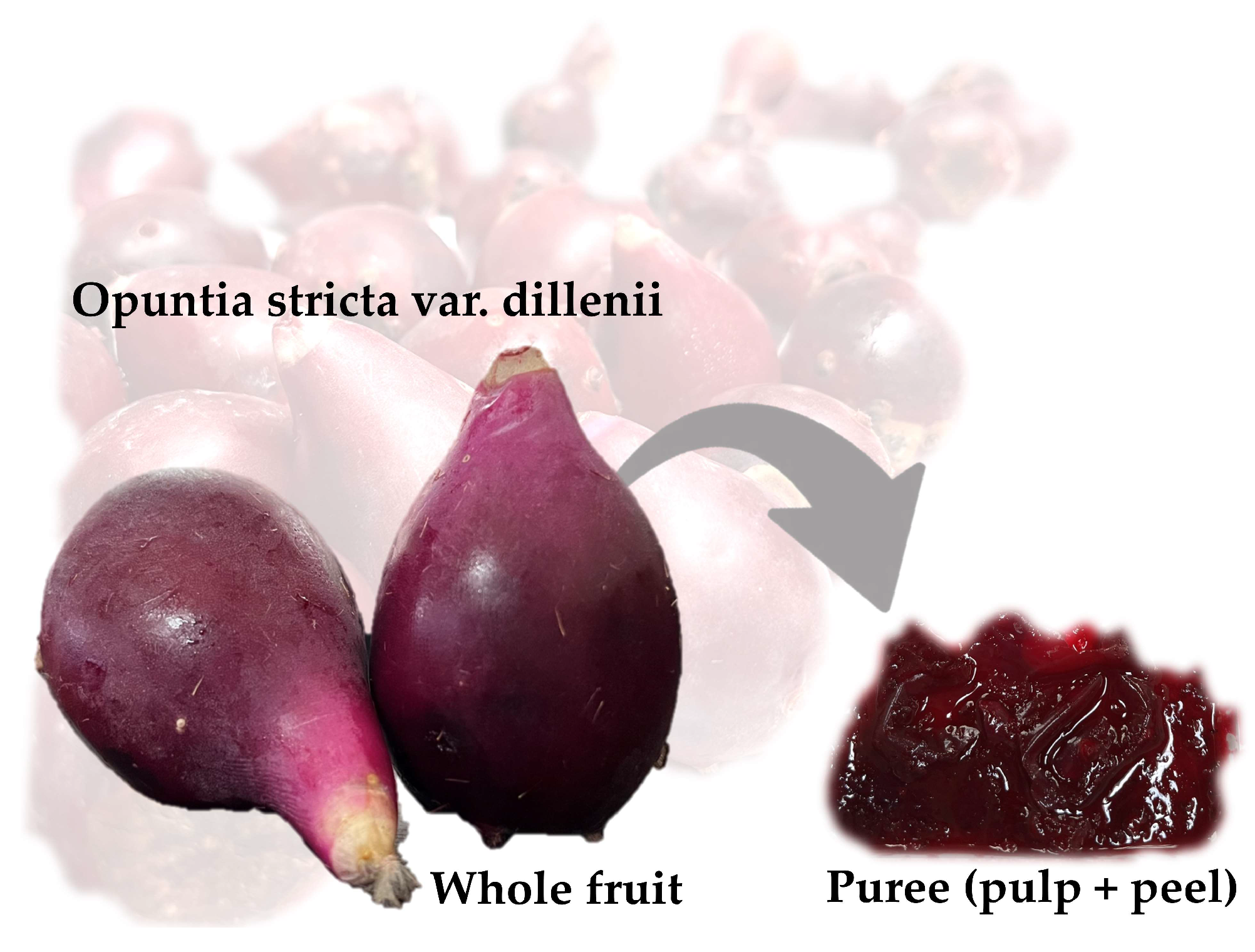
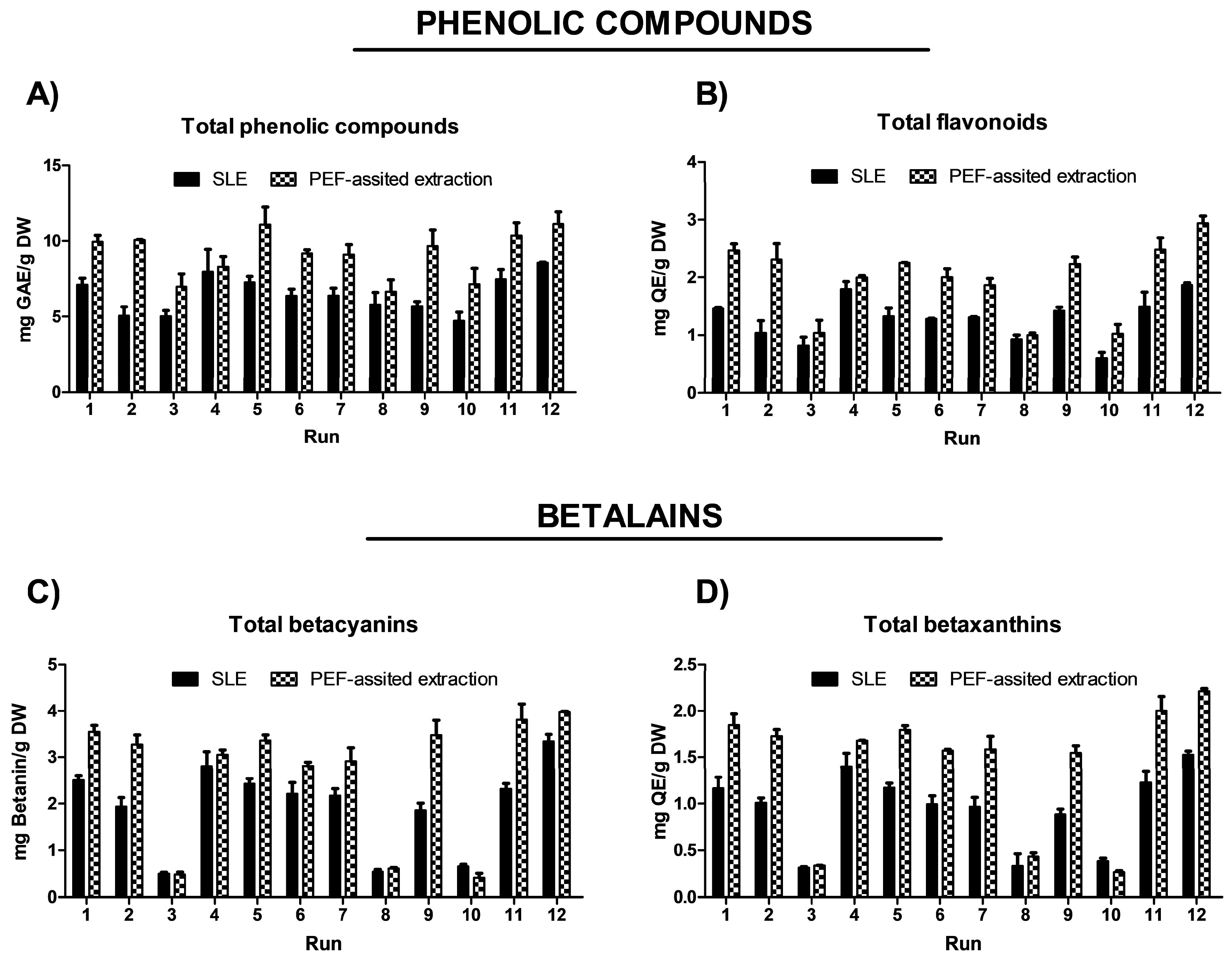
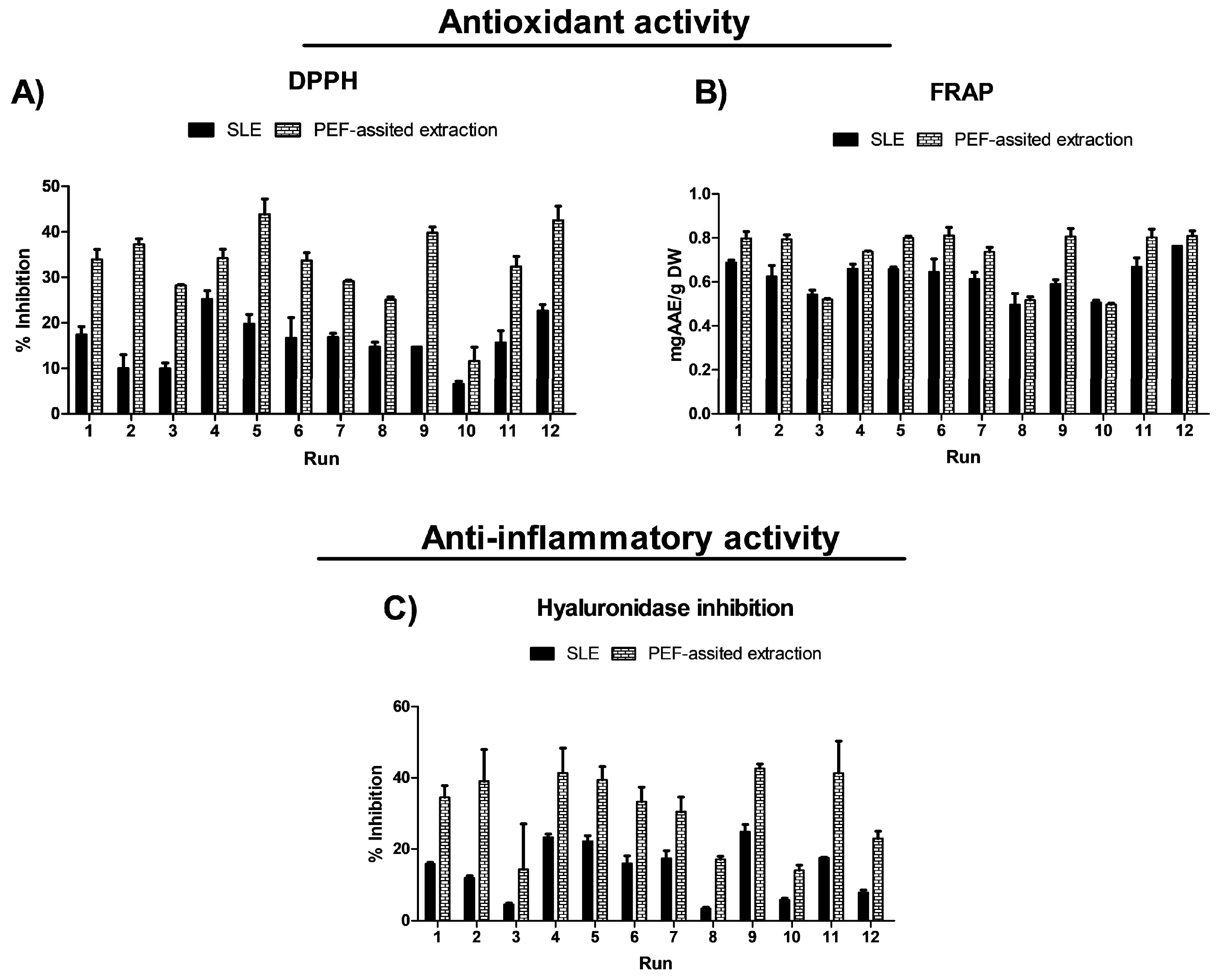
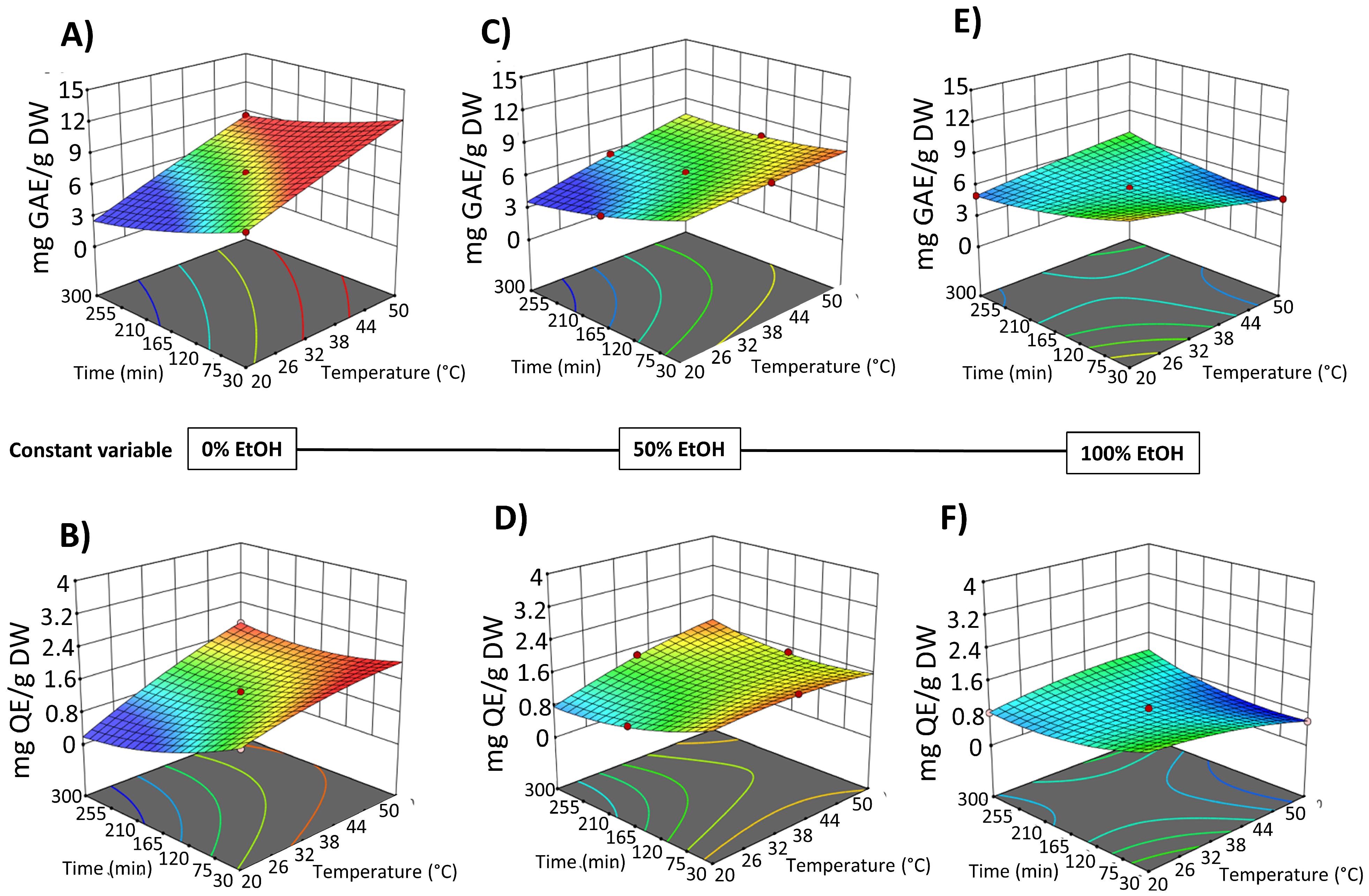
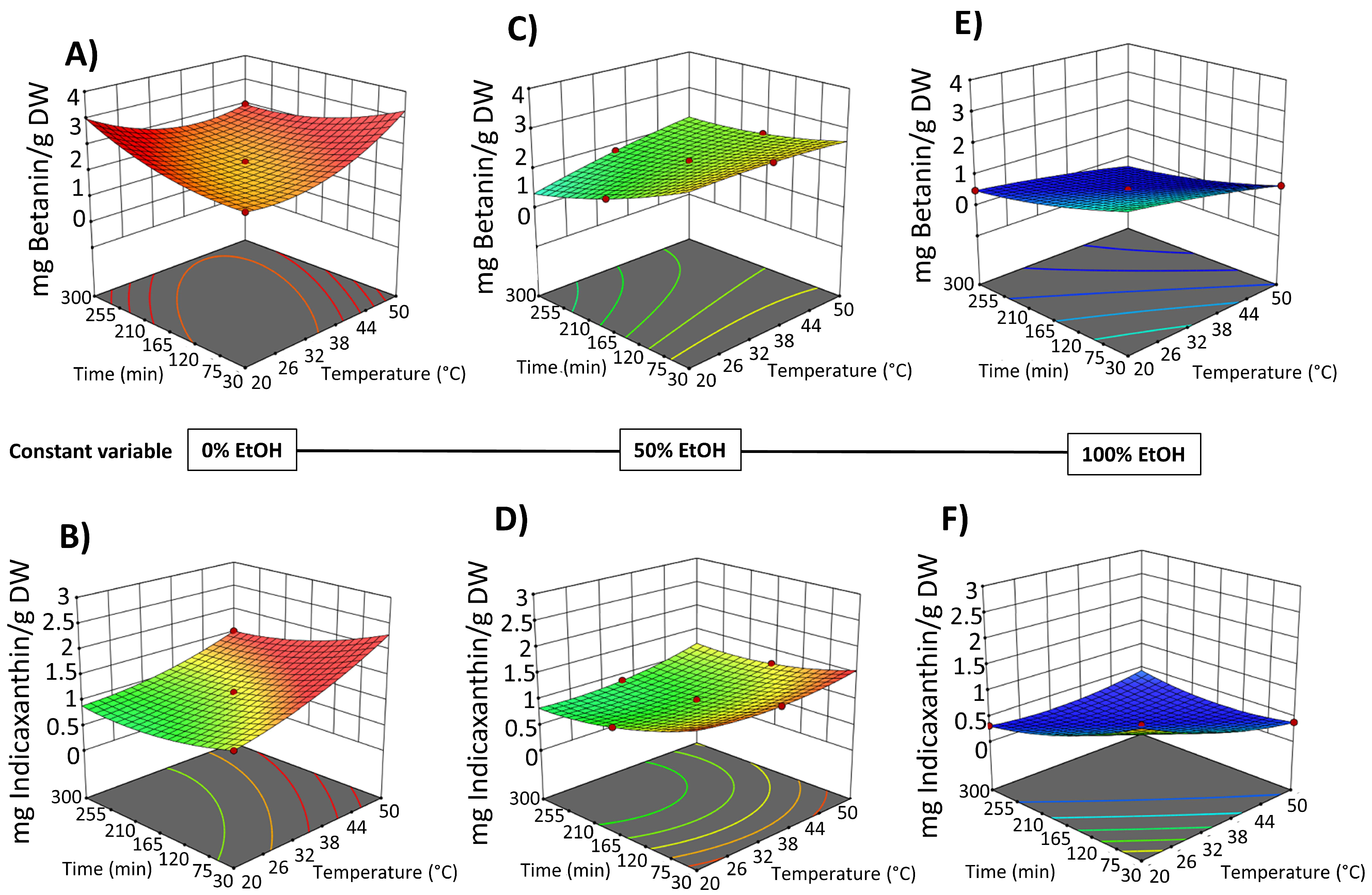
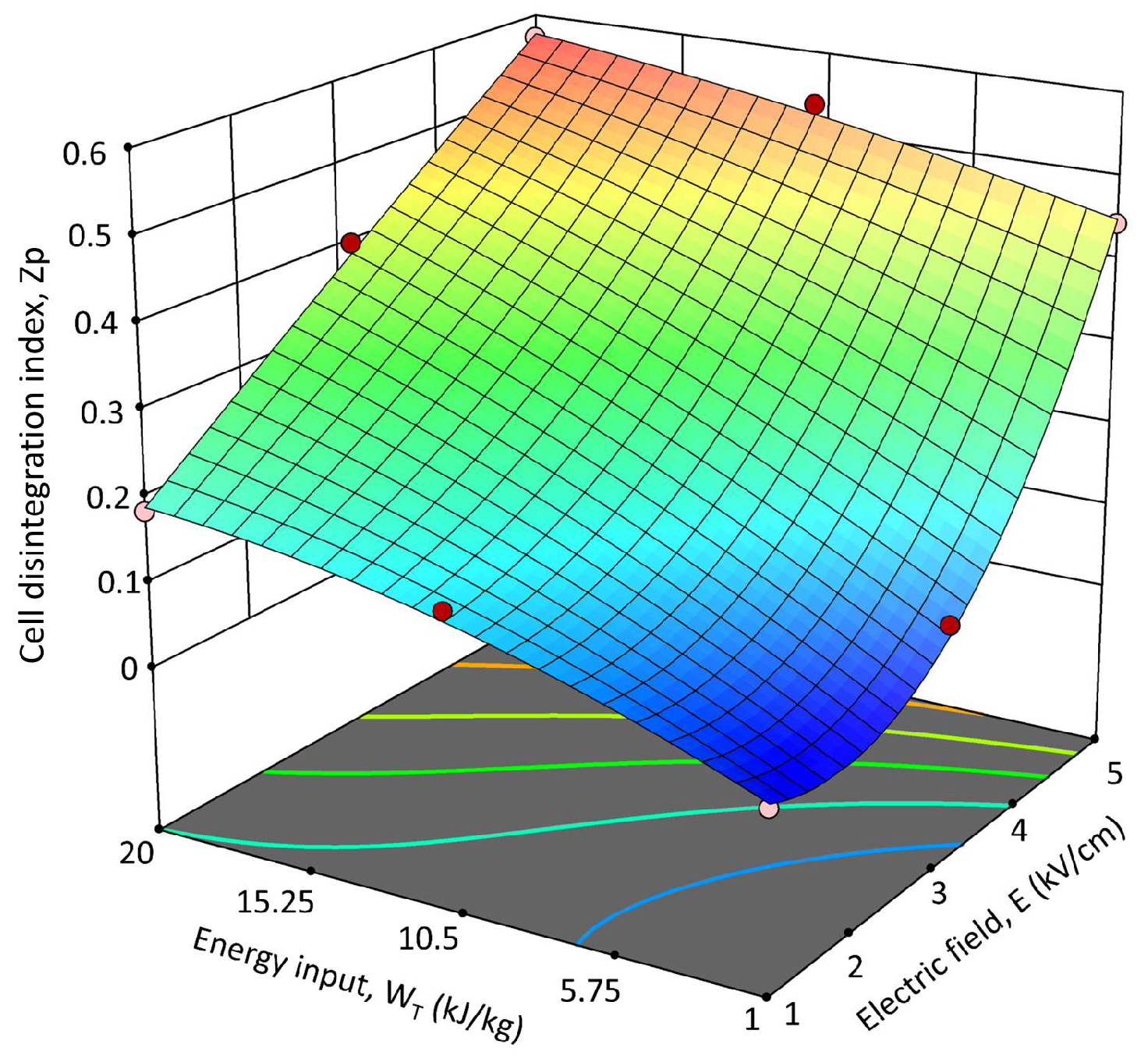
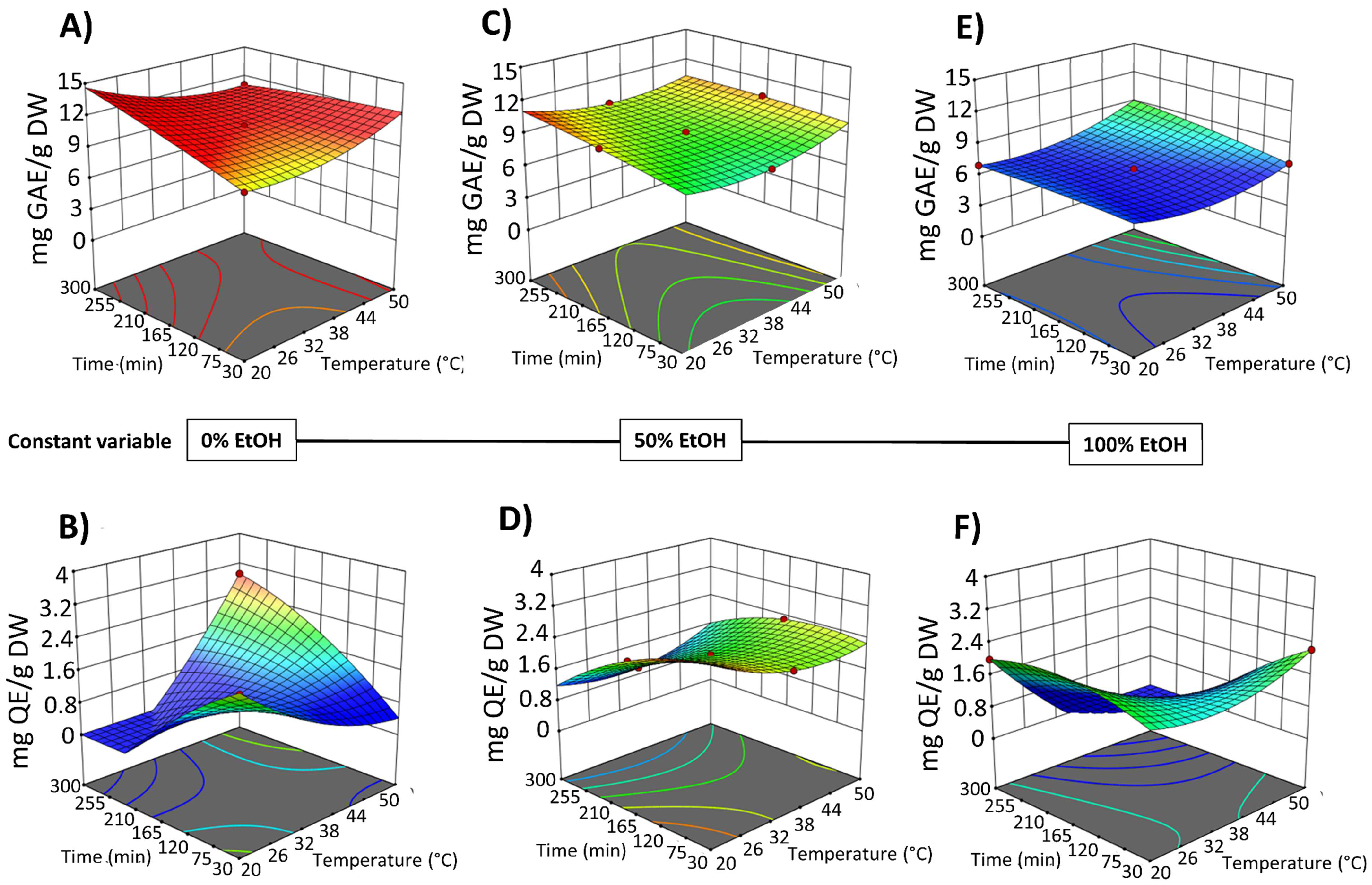
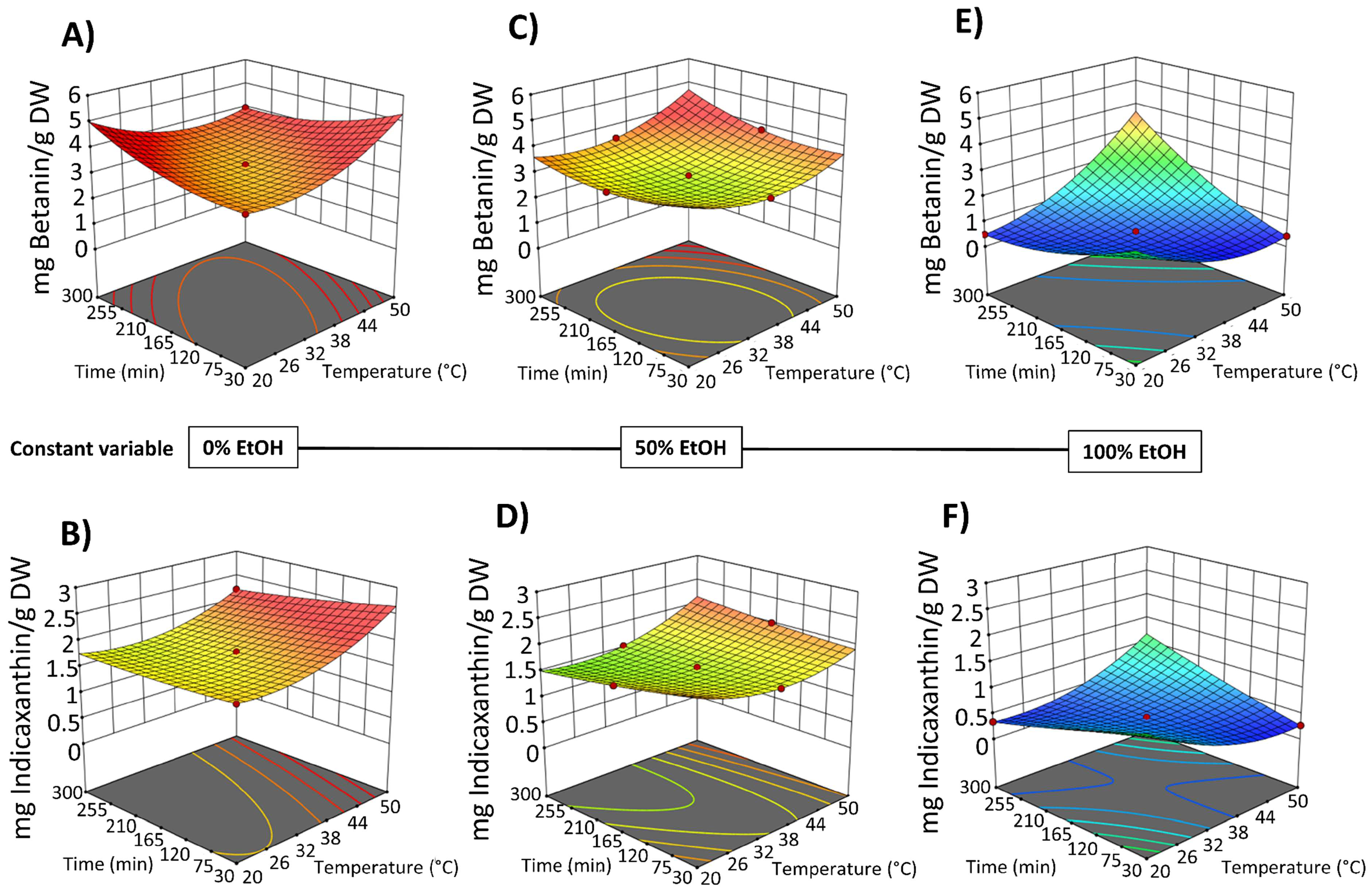
| Run | Variables | Response | |
|---|---|---|---|
| E (kV/cm) | WT (kJ/kg) | Zp | |
| 1 | 1 | 1 | 0.013 ± 0.001 a |
| 2 | 1 | 10.5 | 0.147 ± 0.007 bc |
| 3 | 1 | 20 | 0.185 ± 0.009 bc |
| 4 | 3 | 1 | 0.080 ± 0.005 ab |
| 5 | 3 | 10.5 | 0.238 ± 0.012 c |
| 6 | 3 | 20 | 0.399 ± 0.021 de |
| 7 | 5 | 1 | 0.444 ± 0.058 ef |
| 8 | 5 | 10.5 | 0.535 ± 0.061 fg |
| 9 | 5 | 20 | 0.571 ± 0.054 g |
| Run Number | Factor X1: Temperature (°C) | Factor X2: Time (min) | Factor X3: Ethanol in Water (%) |
|---|---|---|---|
| 1 | 20 | 30 | 0 |
| 2 | 20 | 165 | 50 |
| 3 | 20 | 300 | 100 |
| 4 | 35 | 30 | 50 |
| 5 | 35 | 165 | 0 |
| 6 | 35 | 165 | 50 |
| 7 | 35 | 165 | 50 |
| 8 | 35 | 165 | 100 |
| 9 | 35 | 300 | 50 |
| 10 | 50 | 30 | 100 |
| 11 | 50 | 165 | 50 |
| 12 | 50 | 300 | 0 |
| Peak * | Compound | Family | mg/g DW |
|---|---|---|---|
| 1 | Piscidic acid | Phenolic acid | 0.72 ± 0.31 A |
| 2 | Betanin | Betalain | 2.13 ± 0.49 A |
| 3 | Isobetanin | Betalain | 0.84 ± 0.14 A |
| 4 | 2′-O-apiosyl-4-O-phyllocactin | Betalain | 0.52 ± 0.04 A |
| 5 | 5″-O-E-sinapoyl-2′-apyosil-phyllocactin | Betalain | 1.11 ± 0.06 A |
| 6 | Neobetanin | Betalain | 1.18 ± 0.18 A |
| 7 | Quercetin-3-O-rhamnosyl-rutinoside (QG3) | Flavonoid | n.d. |
| 8 | Quercetin glycoside(QG2)—Quercetin hexose pentoside | Flavonoid | 0.01 ± 0.00 A |
| 9 | Isorhamnetin glucoxyl-rhamnosyl-pentoside (IG2) | Flavonoid | 0.11 ± 0.02 A |
| Sum of major betalains | 5.78 ± 0.36 A | ||
| Sum of major flavonoids | 0.12 ± 0.03 A | ||
| Biological activities | |||
| Antioxidant activity | |||
| FRAP | mg AAE/g DW | 0.72 ± 0.03 A | |
| DPPH | % of inhibition | 15.31 ± 0.77 A | |
| Anti-inflammatory activity | |||
| Hyaluronidase inhibition | % of inhibition | 31.76 ± 4.40 A | |
| Peak * | Compound | Family | PEF-Assisted SLE | Increment Yield |
|---|---|---|---|---|
| (mg/g DW) | (%) | |||
| 1 | Piscidic acid | Phenolic acid | 1.70 ± 0.11 B | +136% |
| 2 | Betanin | Betalain | 3.00 ± 0.01 B | +41% |
| 3 | Isobetanin | Betalain | 1.26 ± 0.03 B | +50% |
| 4 | 2′-O-apiosyl-4-O-phyllocactin | Betalain | 1.02 ± 0.03 B | +96% |
| 5 | 5″-O-E-sinapoyl-2′-apyosil-phyllocactin | Betalain | 2.21 ± 0.64 B | +99% |
| 6 | Neobetanin | Betalain | 1.82 ± 0.01 B | +54% |
| 7 | Quercetin-3-O-rhamnosyl-rutinoside (QG3) | Flavonoid | 0.02 ± 0.00 B | +100% |
| 8 | Quercetin glycoside(QG2)—Quercetin hexose pentoside | Flavonoid | 0.06 ± 0.01 B | +150% |
| 9 | Isorhamnetin glucoxyl-rhamnosyl-pentoside(IG2) | Flavonoid | 0.24 ± 0.02 B | +118% |
| Sum of major betalains | 9.32 ± 0.63 B | +61% | ||
| Sum of major flavonoids | 0.32 ± 0.03 B | +166% | ||
| Biological activities | ||||
| Antioxidant activity | ||||
| FRAP | mg AAE/g DW | 0.92 ± 0.01 B | +28% | |
| DPPH | % of inhibition | 37.61 ± 0.01 B | +146% | |
| Anti-inflammatory activity | ||||
| Hyaluronidase inhibition | % of inhibition | 45.18 ± 1.12 B | +118% | |
Disclaimer/Publisher’s Note: The statements, opinions and data contained in all publications are solely those of the individual author(s) and contributor(s) and not of MDPI and/or the editor(s). MDPI and/or the editor(s) disclaim responsibility for any injury to people or property resulting from any ideas, methods, instructions or products referred to in the content. |
© 2025 by the authors. Licensee MDPI, Basel, Switzerland. This article is an open access article distributed under the terms and conditions of the Creative Commons Attribution (CC BY) license (https://creativecommons.org/licenses/by/4.0/).
Share and Cite
Gómez-López, I.; Pirozzi, A.; Carpentieri, S.; Portillo, M.P.; Pataro, G.; Ferrari, G.; Cano, M.P. Pulsed Electric Field-Assisted “Green” Extraction of Betalains and Phenolic Compounds from Opuntia stricta var. dillenii Prickly Pears: Process Optimization and Biological Activity of Green Extracts. Foods 2025, 14, 2934. https://doi.org/10.3390/foods14172934
Gómez-López I, Pirozzi A, Carpentieri S, Portillo MP, Pataro G, Ferrari G, Cano MP. Pulsed Electric Field-Assisted “Green” Extraction of Betalains and Phenolic Compounds from Opuntia stricta var. dillenii Prickly Pears: Process Optimization and Biological Activity of Green Extracts. Foods. 2025; 14(17):2934. https://doi.org/10.3390/foods14172934
Chicago/Turabian StyleGómez-López, Iván, Annachiara Pirozzi, Serena Carpentieri, María P. Portillo, Gianpiero Pataro, Giovanna Ferrari, and M. Pilar Cano. 2025. "Pulsed Electric Field-Assisted “Green” Extraction of Betalains and Phenolic Compounds from Opuntia stricta var. dillenii Prickly Pears: Process Optimization and Biological Activity of Green Extracts" Foods 14, no. 17: 2934. https://doi.org/10.3390/foods14172934
APA StyleGómez-López, I., Pirozzi, A., Carpentieri, S., Portillo, M. P., Pataro, G., Ferrari, G., & Cano, M. P. (2025). Pulsed Electric Field-Assisted “Green” Extraction of Betalains and Phenolic Compounds from Opuntia stricta var. dillenii Prickly Pears: Process Optimization and Biological Activity of Green Extracts. Foods, 14(17), 2934. https://doi.org/10.3390/foods14172934












